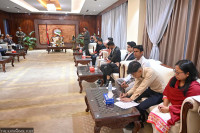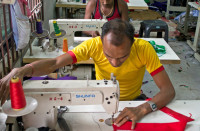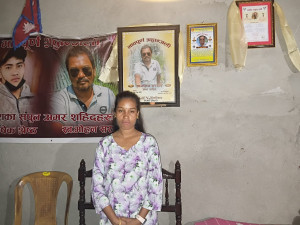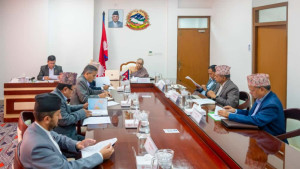Opinion
A fight for food
Policymakers must focus on using food sovereignty as a framework to alleviate hunger and malnutrition
Jyoti Bista
Nepal's National Planning Commission (NPC) defines poverty in terms of nutrition, as not having the wherewithal to buy food items worth 2,124 calorie per person per day, in addition to some non-food items. Only 24 percent of the population in Nepal is under absolute poverty, as per the NPC calculation, which is based on the calorie intake needed to survive. In that same vein, development economist Michael Lipton categorises someone as living in ultra-poverty if they receive less than 80 percent of the minimum calorie intake while spending 80 percent of their income on food.
Nutrition and poverty
The 2013 International Food Policy Research Institute Global Hunger Index (GHI) report shows that Nepal's hunger status has decreased by 38.21 percent in the last two decades. The report combines three hunger-related indicators—the proportion of undernourished people in the population, the prevalence of underweight children and the mortality rate of children. The report shows that, on the GHI index, Nepal progressed from an 'alarming' hunger rating in 1990 to 'serious' in 2013, with a score of 20.3 against a score of 17.3 respectively; the GHI considers a score of 20-29.9 alarming and 10-19.9 serious.
Similarly, according to the 2011 Nepal Demographic and Health Survey, the growth of 41 percent of children under five is stunted, 11 percent are wasted and 29 percent are underweight. Stunting is a result of chronic malnutrition during pregnancy to 24 months of age. More than the daily intake of required calories, the problem lies with food culture and child-care practices. Stunting can also be caused by recurrent or chronic illness.
The link between malnutrition, hunger and poverty is underscored in the definition of the Millennium Development Goal (MDG) 1: Eradicate extreme poverty and hunger. Cross-country studies among different income groups show that for every ten percent increase in income, malnutrition decreases by about five percent. Likewise, the percentage of low birth weight (LBW, births less than 2.4 kg) among all births declines as national income rises. However, in Nepal, poverty reduction has not been matched by a reduction in malnutrition. One of the reasons for this is a change in the consumption pattern and a decline in the quality of food.
Nepal has achieved the MDG 1 C target of halving the proportion of hungry people between 1990 and 2015, according to the 2013 MDG progress report. The target for the prevalence of underweight children (29 percent), at the current level of 28.8 percent, has essentially been met, as has its target for the population below minimum dietary consumption, which at 15.7 percent, is comfortably below the targeted 25 percent.
Nepal has also made significant progress in meeting MDG 1, halving the proportion of people whose income is less than a dollar a day: the rate dropped from 33.5 percent in 1990 to 16.4 percent in 2013. The proportion of the population below the national poverty line has declined to 23.8 percent in 2013 from 46 percent in 1996.
Food sovereignty
However, the national aggregate achievements mask the cross-sectional disparity in MDG progress. The poverty rate in rural Nepal is 27.4 percent, which is nearly twice the rate of 15.5 percent in urban regions. Policy-makers and planners are therefore advised to focus on improving nutrition using food sovereignty as a policy framework for food and agriculture.
Food sovereignty involves protecting and regulating local production and trade towards sustainable rural food security. It puts food providers at centre stage and prioritises the rights of consumers to nutritious food, sourced as locally as possible, rather than internationally tradable commodities. Programmes aimed at improving food availability need to match food aid with improvements in local production; otherwise the dependency on food aid will rise and discourage local producers.
Food sovereignty takes the concept of food security a step further and recognises the importance of looking at how food is produced and exchanged. Its focus is on the development of small-scale, environmentally sustainable, local food networks that build sustainable livelihoods. Nepal's Interim Constitution recognises food sovereignty as a fundamental human right and guarantees some important rights that are relevant to ensuring legal entitlements to the food security.
Building resilience
In order to build nutritional and food security, there must be a focus on facilitating the production and processing of food locally, along with the promotion of local foods for consumption. This is particularly so in remote and food deficit districts. As there is a direct correlation between food deficit and malnutrition, districts that lack food—like Mugu and Jumla districts—are also suffering from malnutrition in general and that of women and children in particular. Though poor and marginalised, these districts have the potential to produce and process locally suitable crops, such as different types of millet like finger millet, chino and kaguno.
The production of nutritious crops at the household level can also help improve food security and nutritional status. Vegetables, fruit and milk can be produced at least in 75 percent of Nepali households, even though not all of them can produce staple foods (mainly cereals).
Furthermore, direct investments need to be made in policies and programmes that focus on those who suffer most or are at risk of suffering from hunger and under- nutrition. These include nutrition interventions in the critical window of opportunity (the first 1,000 days of life), support to children in schools, employment opportunities to build community-based assets and strengthening rural development and agriculture.
Awareness campaigns concerning nutrition, hygiene and the promotion of locally available nutritious foods can effect changes in nutrition. A recent article from the American Public Health Association stated that for every $1 invested in food and nutrition education, there is a $10 return in reduced health care costs. Separate awareness campaigns can be conducted in the mountains, hills and the Tarai regarding the content of a healthy diet for pregnant women. This can be more effective because the availability of food and eating habits differ across geographical regions and ethnic groups.
On an international level, aid agencies like the World Food Program (WFP) must give priority to local products. The UN World Food Program has been providing imported rice to Nepal under the Food for Work programme and thereby, discouraging local production. On the occasion of World Food Day, Ertharin Cousin, head of the WFP, stated that the WFP was now using vouchers for the needy to purchase food on local markets, following accusations that the agency has harmed small farmers by undercutting them with its aid supplies.
Bista is an associate professor at RR Campus




 17.12°C Kathmandu
17.12°C Kathmandu










